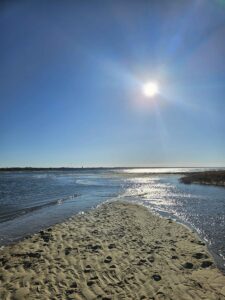EASTHAM — If the wind was right, Eli Winslow would be out there. A member of Cape Cod’s small but tight-knit kiteboarding community, he loved nothing more than riding the breeze at the beach with his friends. He was planning to spend the winter in South Africa, chasing the wind off Cape Town.
“He should have been there now,” says his mother, Cara Winslow of Yarmouth Port.
Winslow, 29, died of a spinal cord injury on Oct. 12 after hitting a sandbar while kiteboarding at Bee’s River in Eastham. He wasn’t the only kiteboarder there, but the others were in the process of leaving when they witnessed the accident. Winslow’s death sent shock waves through the Cape’s kiteboarding community and brought a renewed focus on safety to discussions among its members.
In kiteboarding, a large power kite pulls the rider, with feet strapped to a board, across water or sand. “It’s a safe sport,” says Philip Mann, owner of Inland Sea Windsurf Co. in West Dennis. “But like in any sport, things can go wrong.”

Bee’s River is ideal for kiteboarding because the marsh shields the water’s surface from the wind. “On a certain angle of wind, you’re able to ride in virtually glassy water when it’s blowing 30 knots,” says Eric Gustafson, a kiteboarding instructor in Wellfleet. He says that kiteboarders from Boston often come to the Cape to take advantage of the favorable conditions.
But there are dangers associated with the river, too. The water’s smooth surface conceals a strong current at mid-tide, and it can be difficult to judge the location of sandbars while airborne. Kiteboarders generally move a short distance north to First Encounter Beach when the tide is going out because of the hazards.
Mann doesn’t think a lapse in judgment caused the October 12 accident. “He was a very experienced kiter,” Mann says. “He always knew what he was doing.”
Mann says he believes that either a line on Winslow’s kite got twisted or he was doing a high-level move that went wrong.
A Difficult Rescue
When Eastham police arrived at the scene on Oct. 12, Officers Anthony Rivera and Michael Reveruzzi swam across the river to reach Winslow, took over CPR from those who got there first, and returned him on a paddleboard to the opposite shore.
Both Rivera and Reveruzzi checked into Cape Cod Hospital later that day for “symptoms of saltwater inhalation and hypothermia,” according to a press release. Both were released by the next day. Eastham Police Chief Adam Bohannon said that swimming across the river was “one of the more challenging decisions” his officers faced, due to a lack of formal guidelines for handling ocean rescues.
Massachusetts requires all prospective officers to pass a swimming test, but police uniforms are far from the ideal equipment for a water rescue.
Since Winslow’s death, Mann has been brainstorming ways to make the beaches safer for everyone.
“They take the rescue boards away when they close the beaches at the end of the season,” he says. “Maybe we can figure out a way to have those available, maybe with a first-aid kit, and ideally a defibrillation device.”
“It always hits home when there’s an accident,” he says, “but this one was by far the worst.”
Gustafson says that kiteboarding accidents are rare, especially among the experienced. But Winslow’s death was followed a week later by an accident at Sengekontacket Pond on Martha’s Vineyard, when a sudden change in wind direction during a jump caused windsurfing hall-of-famor Nevin Sayre, 64, to crash face down into the water, knocking him unconscious. A fellow kiteboarder, Robert “Bear” Harding, rescued Sayre from the water and administered CPR, saving his life.
“October was a heartbreaking month for us,” Gustafson says.
According to Gustafson, it’s usually newcomers that get hurt, not the veterans. That’s because inexperienced kiters don’t always know when to let go of the kite to avoid an accident or when to avoid launching altogether.
“The dangerous guy,” Gustafson says, “is the one who bought a kite on eBay and thinks he’ll teach himself.”



